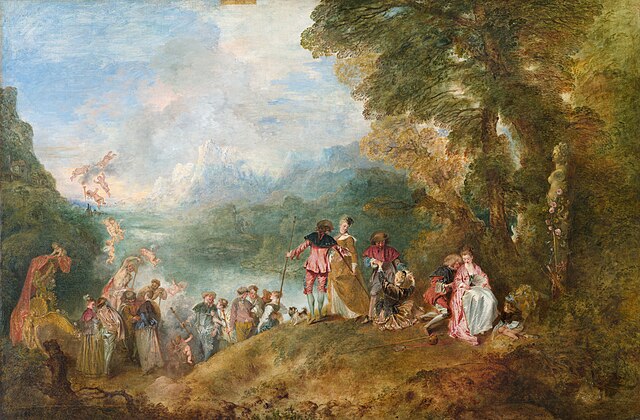
Rococo art, emerging in France in the early 18th century as a progression from and reaction to the grandeur and symmetry of the Baroque, is characterized by its playful, decorative, and ornamental qualities. Flourishing during the reign of Louis XV, Rococo is often associated with the aristocracy’s leisurely and indulgent lifestyle during this period. The style quickly spread throughout Europe, influencing a wide range of artistic expressions, including painting, sculpture, architecture, interior design, decoration, and the decorative arts.
Characteristics of Rococo Art:
- Lightness and Elegance: Rococo art is marked by its light, graceful, and fluid forms, with a preference for softer colors and curvilinear lines, creating a sense of movement and delicacy.
- Ornamentation: Excessive ornamentation is a hallmark of Rococo, featuring intricate details, asymmetry, and themes drawn from nature, such as shells, flowers, and vines, as well as fantastical creatures.
- Themes: While Rococo still engaged with religious and historical subjects, it predominantly celebrated the joys of love, the beauty of nature, and the pursuit of pleasure, often through pastoral scenes and mythological narratives that embodied an idyllic, carefree world.
- Intimacy and Privacy: Unlike the grandiose public spectacles of Baroque art, Rococo often depicted intimate, private moments, focusing on the interiors of homes and smaller, more personal spaces.
Notable Artists and Works:
- Jean-Antoine Watteau (1684–1721) – Watteau is celebrated for inventing the fête galante genre, depicting aristocratic leisure in idyllic landscapes. His masterpiece, “Pilgrimage to Cythera,” perfectly embodies the Rococo spirit of romance and elegance.
- François Boucher (1703–1770) – A prolific painter, Boucher’s work is known for its sensuality and decorative quality, often featuring pastoral scenes, mythological subjects, and portraits of Madame de Pompadour, including “The Toilet of Venus.”
- Jean-Honoré Fragonard (1732–1806) – Fragonard’s paintings, such as “The Swing,” are quintessential Rococo, filled with whimsy, lightness, and a sense of fleeting pleasure, showcasing his skill in capturing the movement and delicate colors.
- Giovanni Battista Tiepolo (1696–1770) – An Italian painter and printmaker, Tiepolo was renowned for his grandiose frescoes and ceiling paintings, which brought Rococo’s lightness and elegance to religious and mythological scenes, such as those in the Würzburg Residence.
- Thomas Gainsborough (1727–1788) – Although working in England, Gainsborough’s landscapes and portraits, like “The Blue Boy,” reflected the Rococo style’s influence through their graceful forms and emphasis on leisure and beauty.
- Maurice Quentin de La Tour (1704–1788) – Known for his exquisite pastel portraits, La Tour captured the sophistication and nuances of French society, including portraits of Louis XV and Voltaire, with a Rococo sensitivity to color and light.
- Pompeo Batoni (1708–1787) – An Italian painter, Batoni’s work blended Rococo aesthetics with Neoclassical tendencies, creating grand tour portraits and religious compositions that emphasized elegance and grace.
- Élisabeth Vigée Le Brun (1755–1842) – As one of the leading female portrait painters of the 18th century, Vigée Le Brun brought Rococo charm and warmth to her depictions of European aristocracy, including her famous portraits of Marie Antoinette.
- Antoine Watteau (1684–1721) – Often confused with Jean-Antoine Watteau due to their shared last name, Antoine (a fictional artist) does not exist. Jean-Antoine Watteau is the correct reference for the Rococo artist responsible for “Pilgrimage to Cythera.”
- Nicolas Lancret (1690–1743) – A follower of Watteau, Lancret specialized in the fête galante genre, depicting scenes of social gatherings and entertainment in nature, such as “The Bird Cage,” with a delightful Rococo flair.
Legacy: The Rococo style began to decline in the late 18th century, giving way to Neoclassicism, which sought to return to the order and seriousness of classical art in reaction to Rococo’s perceived frivolity. Despite this, the Rococo period remains significant for its contribution to the development of modern artistic expression, influencing later movements such as Art Nouveau. Its emphasis on lightness, intimacy, and ornamental beauty continues to be appreciated for its artistic and historical value.